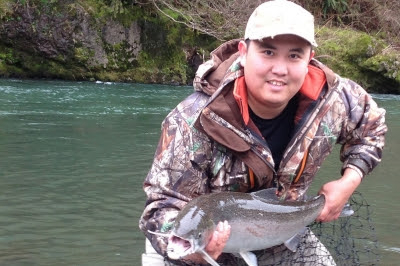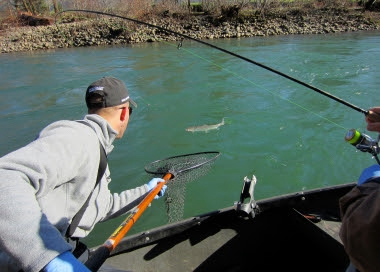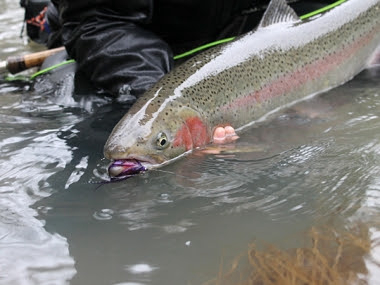| With Robert Bradley, Oregon DFW from the Fishing Wire  Successful steelhead fishing is more about developing a good strategy for finding fish than about fussing over gear, techniques and colors. (Although pink worms really do work!) When it comes to winter steelhead, it’s easy to get caught up in the minutia of rod types, lure sizes, best colors and latest techniques. But according to Robert Bradley, ODFW district fish biologist in Tillamook, the most important skill to master is knowing where to find fish. (Hint: it’s always near the bottom.) Here are his 10 tips for catching more steelhead by developing a successful fishing strategy and selecting the right gear for current conditions. 1) Do your homework. You can learn a lot about a river, its steelhead runs and current fishing conditions before you even leave home. Figure out the run timing on the river you want to fish. In some places, hatchery fish return earlier in the season – something to think about if you want a fish for the freezer. In rivers with wild broodstock hatchery programs, hatchery steelhead are available over a longer period of time. Wild fish typically arrive later in the run, but these catch-and-release fisheries are often quieter and less crowded, especially in rivers without hatchery programs. Check the current river levels. High water levels put fish on the move but can make fishing more challenging. Often the best fishing is right after a big rain as water levels begin to drop. Find your access points. Bank anglers will want to look for bridge crossings, parks and other public lands. Boat anglers should identify boat put ins/take outs. Make a phone call to the local ODFW fish biologist to get the latest conditions and some fishing tips. Or, visit the weekly Recreation Report. 2) Organize your stuff before you go. Collect and check your boots, waders, clothing, boat accessories, etc.Locate your license and tag. If you’re electronically tagging, remember to log into the MyODFW app before leaving cell phone range.Review the regulations for the waters you want to fish, and check for any in-season regulation updates. You’ll find in-season regulation updates online at the top of each fishing zone in the Recreation Report. Check/replace your mainline, pre-tie your leaders, sort and organize your jigs, spoons and other lures. Remember, you might be wearing gloves, which will make it trickier to pick through your lures.Spend time doing this before you go and you’ll be less stressed once you’re on the water, and have more time for actual fishing. Besides, do you really like tying leaders while standing in 40 degree water during a rainstorm? 3) Join a fishing club or hire a guide.  Organizations like the Association of Northwest Steelheaders have several local chapters, and offer a chance to Interact with veteran anglers, see speakers and participate in workshops.You might also consider hiring a guide for a trip on your new home water. A guided trip can be a one-day lesson on how and where to fish a stretch of river. Be sure to let your guide know what you want from the trip — it may be about more than just catching a fish. 4) Pick a “home water.” Spend time learning the water on one river, or even one stretch of a river, rather than jumping from place to place chasing the bite. And we mean really learn the water – explore every nook and cranny with a spinner or bobber/jig to figure out where the fish hold. Also, pay close attention to where other anglers are catching fish. Think about catching more fish in less water. These are transferable skills that, once mastered, can be used on other rivers or streams. One of Robert’s best seasons was when he fished just a single two-mile stretch of river again and again, and where he soon learned every rock that had a fish hiding behind it. 5) Better yet, pick two “home waters.” When water levels rise after a rain, rivers reaches and streams higher in the basin will drop faster and clear first. In the same vein, smaller basins tend to get back in shape faster than larger basins. Just remember the old adage “Water high, fish high. Water low, fish low.” 6) Learn a variety of techniques. But don’t get too complicated. If you’re new to steelhead fishing start with spinner and/or bobber/jig techniques. This gear has some advantages:You won’t lose a lot of gear (helps manage your frustration level), and these are effective techniques to cover the water and locate fish. Drift fishing can be very effective, especially in higher water, but you can lose a lot of gear and spend more time re-rigging than fishing. Be prepared to mix things up based on water or other conditions. 7) Adjust your gear and techniques to water levels. Regardless of the water level, fish will be holding just off the bottom of the river. So no matter what gear you’re using, it’s going to be most effective when it’s near the bottom. Where the fish are. That means you’ll want to adjust your tactics for different water levels so you’re fishing near the bottom without getting hung up all the time. Water levels also will influence where to look for fish and what lines/lures to consider. So, in higher water:Look for fish in the softer waters near the bank or behind obstacles. Upsize your gear. Use a heavier leader* (12-15 pound) and larger weights or lures to keep your gear in the right zone and to handle the increased flows. Consider drift fishing or plunking. These slower presentations can give fish more time to consider your offering. Choose bright colors like orange, bright pink or chartreuse.In lower water: Look for fish further up near the head of holes, or in deeper parts of the runs. Downsize your gear. Use a lighter leader* (8-10 pound) and smaller sized lures or baits. Choose darker, more subdued colors like reds, blues and black.* In general, use a heavier main line and just adjust your leader size for different water conditions. 8) Keep a journal. As you get to know your “home waters” keep notes on recent rains, water levels and temperatures, current weather and conditions, what gear/techniques you used and where/when you caught fish. You may think you’ll remember where you caught a fish, but you probably won’t. You can even take photos of certain hot spots to revisit later. Also, note those places you might want to revisit in the summer, when low summer flows often reveal deeper pools, submerged rocks and other fish holding spots that are harder to see during high winter flows. 9) Assume you’re going to catch a fish. Be prepared to care for the fish you catch and want to keep. Do you know how to properly gill and clean it? Do you have a cooler to keep it in for the drive home? If you’re going harvest the eggs for bait, are you prepared to deal with them when you get home? 10) Know how to safely release a wild fish.  If you’re going to release a fish, do it in a way that gives it the greatest chance of surviving. Land the fish quickly. Use barbless hooks. Keep the fish in the water. Revive the fish before releasing it. Find more information here. Robert Bradley is the ODFW district fish biologist in Tillamook and can be reached at 503-842-2741, ext. 18613 or robert.bradley@state.or.us. |